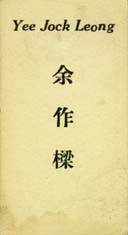 |
THE LIFE
|
|
 |
THE LIFE
|
|
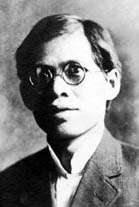 Yee Jock Leong circa 1930. |
My great-grandmother burned a lot of my great-grandfather's belongings after his death. I assume we lost quite a bit of family information in the flames.
Very few documents survived the flames, such as letters written in classical Chinese. I cannot make much sense out of what is left, but I can fill in a few details of his life from what little evidence remains. For instance, the two cards above are -- I am told -- both his and that one is a birth name (presumably the one at left) and the other is a married name. He often went by the name of Yee Jackson, which causes much confusion as Jackson is listed as his surname in some official records. The photo at right shows Yee Jock Leong in what I believe to be the 1930s.
In March 2004, I traveled to San Francisco to visit the Pacific Region office of the National Archives and Records Administration (which is actually located in San Bruno, California). There I discovered that a Chinese Exclusion Act (CEA) file on him. While I am still angry at the level of persecution faced by Chinese and other immigrants who tried (and still try) to enter this country, CEA files contain a gold mine of information for those researching their Asian ancestry. (Note that the laws were expanded to exclude immigrants from other nations.)
There may have been more records in the San Francisco area at one time, but many documents about Chinese and other Asian immigrants held by U.S. immigration authorities were destroyed by a 1940 fire at the Angel Island Immigration Station in San Francisco Bay (the entry point for many Asian immigrants on the West Coast). I have reason to believe -- by references to documents concerning my great-great-grandfather, Yee Kim Wo -- that more records once existed.
I learned a lot about my great-grandfather's family from the San Francisco trip. To compare what I've learned, compare this page to its predecessor.
Now I will proceed with what I know of Yee Jock Leong's life. . .
Yee Jock Leong was born -- according to his birth certificate -- on January 15, 1884, at 741 Sacramento Street in San Francisco. (I have reason to believe that his birthdate was Febuary 15, 1884, as I will explain later.) I learned this from a typed copy of his birth certificate that was in the material that was in the possession of my grandmother, Yee Jock-Leong's daughter Yut-Seul Yee, at the time she died on June 12, 1979. The certificate said his parents were Yee Kim Wo and Wong Shee.
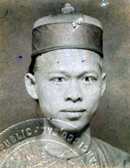 Yee Jock Leong circa 1903. |
For years, I wondered if the birth certificate was some kind of fake, but in his CEA file I found original copies of his birth certificate, issued on June 21, 1904, by the Office of the County Recorder, City and County of San Francisco. The birth certificate refers to an affidavit of Wong Shee, but the affidavit was not included in the CEA file. Many San Francisco records were destroyed in the earthquake and fire of 1906, so I do not know if Wong Shee's affidavit still exists.
The original birth certificate includes a photograph of a 19-year-old Yee Jock Leong (right). The photograph must have been taken in China, for documents with versions of the photography arrived in the United States prior to Yee Jock Leong's return.
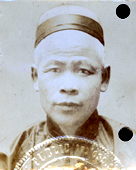 Yee Kim Wo circa 1903. |
As I learned later, Yee Jock Leong's father, Yee Kim Wo (right), first came to the United States in K.S. 2nd year (the second year of Emperor Kwang Sui), or 1876. There are no records of when during the year, nor of what ship he came on. I estimate his date of birth to be circa 1850. (This is an unadulterated guess, however.) I do not know when or where Yee Kim Wo married Wong Shee, but they were living on the second floor of a building at 741 Sacramento Street -- Yee Kim Wo worked as a merchant at Quong Hing Lung & Co., a general merchandise firm on the ground floor of the building -- at the time Yee Jock Leong was born in 1884.
I suspect that Wong Shee was in San Francisco with Yee Kim Wo by 1882, for the first Chinese Exclusion Act was passed by Congress in the Spring of 1882 and signed into law by President Chester A. Arthur on May 6 of that year. The law almost completely prohibited the immigration of Chinese to the United States, because "in the opinion of the Government of the United States the coming of Chinese laborers to this country endangers the good order of certain localities within the territory thereof." Those who were already in the United States at the time the act was passed, but who left the country afterward, could re-enter the United States ONLY if they had obtained a certificate prior to their departure from a U.S. port. Legal immigrants, such as Yee Kim Wo, were denied U.S. citizenship, however.
Yee Kim Wo held a shaving ceremony for Yee Jock Leong at the Hom Fa Lau Restaurant in San Francisco shortly after the birth. From what I can find out by searching the Web, head-shaving ceremonies are common in East Asia. In Buddhist families, for example, when a baby is about one month old his head is gently shaved and cotton tied around the wrists in the belief that the ceremony will bring blessings to the child. Yee Kim Wo did not offer any details about Yee Jock Leong's shaving ceremony other than where it was held.
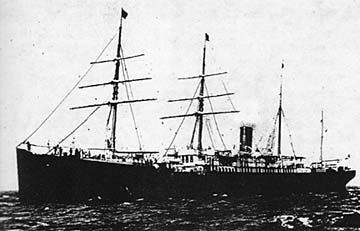 The S.S. Gaelic, date unknown. (Pacific University) |
Yee Kim Wo, Wong Shee and Yee Jock Leong left San Francisco for China in K.S. 12th year, 9th month (circa October 1886) on board the S.S. Gaelic (right). The Gaelic, built by Harland & Wolff of Belfast, Northern Ireland, for the White Star Line, was launched on February 28, 1885, and made Pacific crossings for the Occidental & Oriental Steamship Co., from 1885 to 1904. What was arguably the ship's most historic voyage ended on January 13, 1903, when the ship arrived in Honolulu, Hawaii, with 102 Korean passengers -- the first Korean immigrants to what is now the United States. The Gaelic was overhauled by Harland & Wolff in 1905 and sold to the Pacific Steam Navigation Co. the same year, but was retired and broken up in 1907.
Yee Kim Wo settled Wong Shee and Yee Jock Leong in Lee Yin Village, Sun Ning District, in what is now Guangdong Province in southern China. They lived in a five-room house consisting of two bedrooms, two kitchens and a sitting room. Yee Jock Leong, in an immigration interview in 1903, said the house was on the third alley, fourth house from the corner. Yee Kim Wo, in an interview the same year, said that the house was on the second alley, third house from the corner. Both agreed that a river lay in front of the village and hills lay in back. and that the nearest marketplace was Gong May (Gong Mei), about two blocks (between one and two lees) from their home. Yee Kim Wo said their nearest neighbor was a widow, Soo Ho Shee. Her husband was named Yee Foon. (His married name was Yee Jung Toong.) Yee Jock Leong mentioned another neighbor, Yee Wah Due, whose father, Lee Jung Toon, had previously owned the house where Yee Wah Due lived.
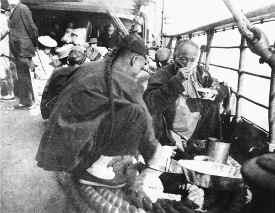 Chinese men eating on deck of the S.S. China, circa 1901. (Smithsonian Institution) |
Yee Kim Wo returned to the United States without his family one year later, in K.S. 13th year, 9th month (circa October 1887).
Passage between the United States and China took several weeks, and often included stops at several ports, such as Shanghai, China, and Yokohama, Japan, along the way.
The image at right shows Chinese passengers eating on the deck of the S.S. China about 1901. Note that they are using the huge coil of rope as a rug.
Yee Kim Wo departed San Francisco again on K.S. 16th year, 10th month, 26th day (December 7, 1891) on board the Gaelic. This time he stayed in China for four years, and while there he and Wong Shee had two more children, a son, Yee Suey Leong, and a daughter, Yee Yah Yit. Yee Suey Leong was born circa 1892 and Yee Yah Yit was born circa 1894.
 The S.S. China, circa 1920. (State Library of Tasmania) |
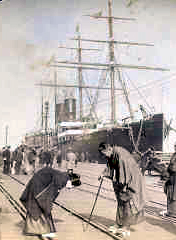 S.S. China at the Pacific Mail dock, Yohohama, Japan, date unknown. |
Yee Kim Wo returned to the United States in K.S. 21st year, 4th month (May 27, 1895) on board the S.S. China (above and right). (The S.S. China was involved in a historical event when a General F.V. Green and detachment of troops from the U.S. Philippine Expeditionary Force annexed Wake Island for the United States on July 4, 1898.)
About 1900 Yee Kim Wo joined the firm of Kow Kee Jan & Co., a general merchandise firm at 840 Clay Street in San Francisco. Yee Kim Wo was interviewed at the firm prior to Yee Jock Leong's return to the United States on April 22, 1903, and Yee Kim Wo is listed as a partner in the firm on May 25, 1903, and on January 8, 1904. U.S. authorities required Chinese businesses to list all partners and the amount of their investment. The CEA prohibited the immigration of laborers, and the government went to great lengths to document whether or not merchants were actually merchants. Immigration authorities could not believe the word of Chinese merchants alone, and interviewed several white businessmen -- including James R. Neutzel and William J. Gardner -- to corroborate Yee Kim Wo's contention that he was a merchant. The white businessmen signed an affidavit certifying Yee Kim Wo's merchant status on April 22, 1903.
Yee Jock Leong later said that Yee Kim Wo returned to China in 1906 and never returned (as of April 14, 1914). Chinatown was destroyed in the great San Francisco earthquake and fire was on April 18, 1906. I do not know if Yee Kim Wo left prior to the earthquake, but is is possible that the disaster prompted his departure.
The family began preparing for Yee Jock Leong's return to the United States before his departure from China. Yee Jock Leong, by virtue of being born in San Francisco, was by the U.S. Constitution an American citizen. The challenge was in proving his citizenship.
From what I can tell from the CEA file, the family began preparing before Yee Jock Leong left China. Immigration authorities began interviewing Yee Kim Wo and associates in April 1903. The goal of the interviews was to determine: 1) whether or not Yee Kim Wo was actually a merchant (see above); and 2) whether Yee Jock Leong was Yee Kim Wo's son. Yee Kim Wo, in his affidavit, attested to both. Four white businessmen -- William J. Gardner, Horace Scott, James R. Keutzel, and J.P. Hughes -- attested in an affidavit that Yee Kim Wo had been a merchant with the firm of Kow Kee Jan & Co. for at least one year -- and Yim Fook Fim attested in his affidavit that Yee Jock Leong was Yee Kim Wo's son, and that he had visited Yee Jock Leong in China.
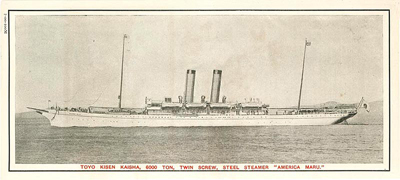 The S.S. America Maru brought Yee Jock Leong back to the United States in 1903. (Collection of Björn Larsson) |
Yee Jock Leong returned to San Francisco on board the S.S. America Maru (right) on August 17, 1903. From what I can tell, the America Maru was built by Swan & Hunter Ltd., of Newcastle-upon-Tyne, England in 1897-1898. The ship may have brought rats carrying Plague to Honolulu, Hawai'i in October 1899. Authorities burned down Honolulu's Chinatown -- where the outbreak was centered -- in an effort to control the epidemic. The Chinese population in Hawai'i dwindled afterward.
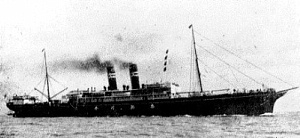 Another view of the S.S. American Maru. (Nostalgic Japanese Steamships) |
The Plague outbreak in Honolulu was not the America Maru's last encounter with history. The ship was part of the Japanese fleet at the Battle of Tsushima on May 27, 1905, picking up survivors of two Russian ships, the cruiser Svyetlana and the destroyer Buistri, sunk by the Japanese cruisers Otowa and Niitaka.
The America Maru's career came to an end during World War II. For at time the vessel served as a hospital ship, but later in the war it was converted to a transport. America Maru was sunk by the USS Nautilus (SS-168) while the submarine was on its eighth war patrol. On March 6, 1944, Nautilus attacked a Japanese convoy about 420 miles north-northwest of Saipan and sunk the America Maru at 22°19'N, 143°54'E. Nautilus then endured but survived a counterattack by the Japanese torpedo boat Otori.
Yee Jock Leong was given a certificate of identity upon his arrival in San Francisco on April 17, 1903, but he was detained on the America Maru for several days while another investigation of his citizenship status was conducted. He was interviewed at length by immigration investigators on August 18, 1903. During that interview, he said he came back to the United States to learn English and business. His father, Yee Kim Wo was interviewed on August 21, as was Ow Yung You. James R. Neutzel and William J. Gardner, two of the white men who signed the affidavit attesting to Yee Kim Wo's merchant status, were likewise interviewed on the 21st and 22nd, respectively.
The interviews of Yee Jock Leong, Yee Kim Wo and Ow Yung You were interesting. They were asked some of the same questions as a check of inconsistencies in their stories. There were some minor inconsistencies, especially regarding the details of the Yee house in Lee Yin Village, but none were apparently significant enough to raise the suspicions of the investigators. Leading questions were asked -- such as about an alleged scar over the right eye of Yee Jock Leong's mother, Wong Shee, to which Ow Yung You skilfully answered, "I never noticed that; it is impolite to stare a lady in the face." An affidavit attesting that Yee Jock Leong was Yee Kim Wo's son was drawn up for Ow Yung You's signature following his interview. It also attested to the fact that Yee Jock Leong was a native-born citizen of the United States.
On August 22, 1903, Chinese inspector Ward E. Thompson recommended that Yee Jock Leong be allowed entry into the country on the grounds that he was both a native-born American citizen as well as a merchant's son. Yee Jock Leong was landed, and was issued both a landing receipt and a certificate that would allow him to obtain copies of his immigration papers.
Some immigration official -- his name appears to be O.P. Fadger -- on August 24, 1903, requested permission to copy some of the documents in order to complete Yee Jock Leong's file.
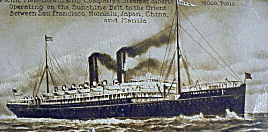 The S.S. Siberia from a Pacific Mail Steamship Co. postcard. (Pacific Mail Steamship Co.) |
Yee Jock Leong returned to China in 1905, I believe to get married. Before departure, he prepared his documents, compiling his birth certificate and other existing documents and, on September 28, 1905, obtaining an affidavit of his birth and nationality. He departed San Francisco on November 1905 on board the S.S. Siberia (right).
The Siberia and its sister ship, the S.S. Korea, were built at Newport News Shipbuilding and Drydock Co. in 1902 for the Pacific Mail Steamship Co. Both were involved in the trans-Pacific trade. The Siberia, for instance, transported Jack London and other war correspondents to Japan and Korea in 1904 to cover the Russo-Japanese War (which ended in Russia's crushing naval defeat at Tsushima). The Siberia and Korea were sold to Toyo Kisen Kaisha of Yokohama, Japan, in 1916, and served for 14 more years. The two ships were scrapped in 1934.
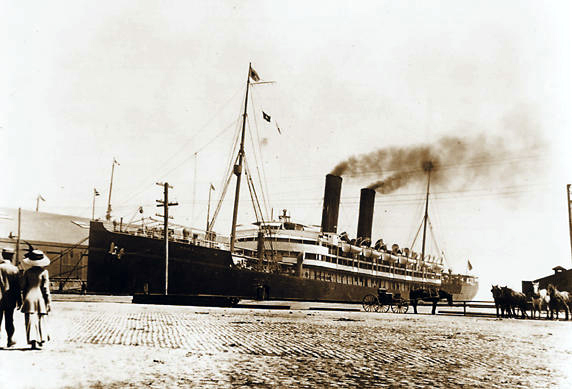 The S.S. Korea, date unknown. (APL Limited) |
By December 24, 1905, Yee Jock Leong had reached his destination, for he was married to Dong Shee on that day in Jew Kee Village, Sun Ning District, Quangdong Province, China. He remained there for almost three years, but returned to San Francisco via the S.S. Korea (above) on 29 April 1908.
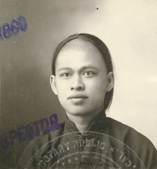 Yee Jock Leong circa 1905. |
This time, the return process was streamlined. Yee Jock Leong was briefly interviewed on April 30. He mentioned that he knew a Yee Him Wah of Po Sang Tong & Co., of 812 Dupont Street, San Francisco. Yee Him Wah was subpoenaed to appear at the Chinese Bureau office and testify on behalf of Yee Jock Leong.
The Chinese inspector recommended that Yee Jock Leong be allowed to enter the United States on May 1, 1908. On May 8, 1903, the documents from the 1903 investigation were forwarded to Chinese Inspector in Charge of the Port of San Francisco.
Little more than four months after Yee Jock Leong returned to San Francisco -- on September 9, 1908, his first son, Yee Kee Quon, was born in Joe Kee Lee Village, Sun Ning District, Quangdong Province, China.
By 1914, Yee Jock Leong was owned and operated a laundry at 438 Main Street, Irwin, Pennsylvania. But he stayed in touch with his family, and wanted to bring his son back to the United States. He may also have wanted to rebury a friend or family member in China, for an exhumation receipt for an Ah Quong, issued by funeral director (also county coroner) W.F. Gormley of Sacramento, California, on May 5, 1913, was found among Yee Jock Leong's papers.
 Yee Jock Leong circa 1914. |
On April 14, 1914, in preparation of what turned out to be his final trip to China, Yee Jock Leong filed a Form 430 requesting a preinvestigation of his citizenship status in order to ease his return. Immigration officials interviewed him in Pittsburgh, Pennsylvania, the same day. Inspector L.B. Spaun reported favorably on Yee Jock Leong's request, and his report began circulating up the beaurocratic ladder.
The inspector in charge at Pittsburgh, W.W. Sibray, forwarded the documents to the commissioner of immigration in San Francisco on May 28, 1914.
In San Francisco, a clerk on Angel Island forwarded Yee Jock Leong's immigration file to the commissioner's office on June 2, 1914. The inspector in charge at San Francisco, Charles Mehan, forwarded the entire file to the Immigration Service's Law Section on June 2. W.E. Walsh of the Law Section approved Spaun's recommendation on the same day, and Samuel W. Backus, the commissioner of immigration at San Francisco, gave his approval on June 3.
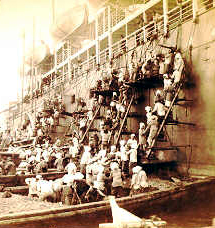 S.S. Siberia is coaled at Nagasaki, Japan, circa 1904. |
Sibray wrote Yee Jock Leong on June 8, 1914, saying that the immigration officer present at the Port of San Francisco will approve his application to be recognized a native-born citizen as soon as he presents himself with the appropriate documents prior to his departure for China. Yee Jock Leong departed for China on June 25 on board the S.S. Siberia.
On September 2, 1914, Yee Jock Leong wrote W.W. Sibray from Diehai, Sun Ning District, Canton (Guangdong) China to let Sibray know that he was planning to return in November with his son. He asked Sibray to contact the immigration officials in San Francisco. Sibray investigated the matter, then on October 20, 1914, kicked the issue upstairs to the commissioner of immigration for Philadelphia, recommending that the San Francisco office was the one that needed to deal with Yee Jock Leong's concerns. The next day, E.E. Grunawalt, commissioner of immigration for Philadelpia, washed his hands of the affair and forwarded the Yee Jock Leong's letter and other materials to the commissioner of immigration's office in San Francisco.
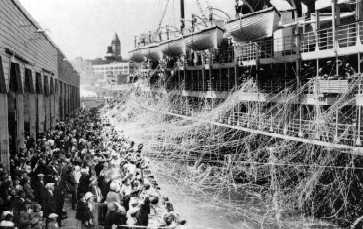 S.S. Siberia Maru (formerly Siberia) departs from San Francisco for Yokohama in 1927. |
Yee Jock Leong did not return in November 1914. Yee Jock Leong sailed from Hong Kong on board the Siberia. He was bound for San Francisco, as indicated in his passenger card. His health was monitored the entire trip, and his health inspection card indicates that he had been vaccinated (against smallpox, I would imagine, but I do not know for sure).
When Yee Jock Leong arrived at the Port of San Francisco on June 29, 1915, he did not have his son with him. There are no records of the Immigration Service's decision as to whether or not he could bring his son to the United States, and I have no other information to explain why he failed to bring his son.
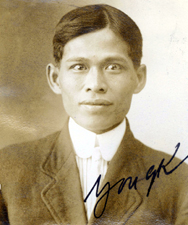 Yee Jock Leong circa 1915. |
Yee Jock Leong was interviewed and granted permission to debark from the ship on the day he arrived.
On July 1, 1915, Yee Jock Leong applied for an certificate of identity from the Immigration Service. He asked that the completed card be delivered to 830 Grant Avenue, San Francisco, where he was apparently staying prior to his return to Irwin, Pennsylvania. The identity card was issued on July 2.
Yee Jock Leong boarded a train in Oakland about July 19, 1915, bound for Chicago. His Pullman ticket is stamped for both the 19th and 20th.
As far as I can tell, he never went back to China.
I believe Yee Jock Leong kept supporting his family financially, even after the dreadful Stock Market Crash of of 1929. He seemed wealthy before the crash. At one time he owned stock in the Ohio River-Panama Coal Field. The stock was purchased -- on margin, apparently -- on October 1, 1910, and he made payments on the stock for several years.
Yee Jock Leong began a new family here, however. He married my great-grandmother, Myrtle Mae Robinson, an orphan of Chinese and Mexican descent on December 17, 1915. I do not know where they met or where the marriage occurred. I do know that my great-grandmother, who was born about 1892 in Santa Barbara, California, was raised by a couple of sisters, Katherine Scott and Hannah M. Robinson, in Ann Arbor, Michigan. Yee Jock Leong's address books contain several Robinson/Robison addresses in the Ann Arbor area.
It wasn't unusual for Chinese men to take additional wives. Dong Shee would have been the first wife (in a Confucian sense), and my great-grandmother would have been a second wife.
The first marriage could have been a false one, too, in an effort to sneak a "paper son" back to the United States. He did not mention a marriage upon his return to the United States in 1908, but he was not asked about one in the immigration interview, either. Nevertheless, the fact that some of the letters seem to indicate the existence of a Chinese family would make this instance unlikely.
I likewise wonder what happened in China on his 1914-1915 trip. He initially intended to stay five months and bring his son to the United States, but instead stayed for more than a year and left his son behind in China. Something clearly did not go as planned.
Yee Jock Leong owned a laundry at 404 West 3rd Street in Dayton, Ohio, for most of his final 20 years. In one of his address books I found what might be draft text for an advertisement. He also owned a kennel, breeding primarily Chows, in Dayton.
He and my great-grandmother had three children: My grandmother, Yee Yut Seul Jackson, born on November 5, 1920, in Dayton; a son, Yee Poy Quon Jackson, born on February 28, 1924, in Dayton (also see birth registration) and died on December 30, 1925, in Dayton; and another daughter, Yee Yet Yut Moy Jackson, born on February 20, 1926, in Dayton (also see birth registration) and died on March 17, 1926, in Dayton. The two children who died were buried in Woodland Cemetery in Dayton. The burial of Yee Poy Quon Jackson was paid for on January 11, 1926.
Yee Jock Leong died on December 4, 1936, in Dayton. According to his death certificate, he died of acute phthysis -- a complication of tuberculosis. Obituaries were published in both Dayton newspapers, The Dayton Daily News and the Dayton Journal. He was buried in a numbered grave in Calvary Cemetery.
Questions? Comments? E-mail me.